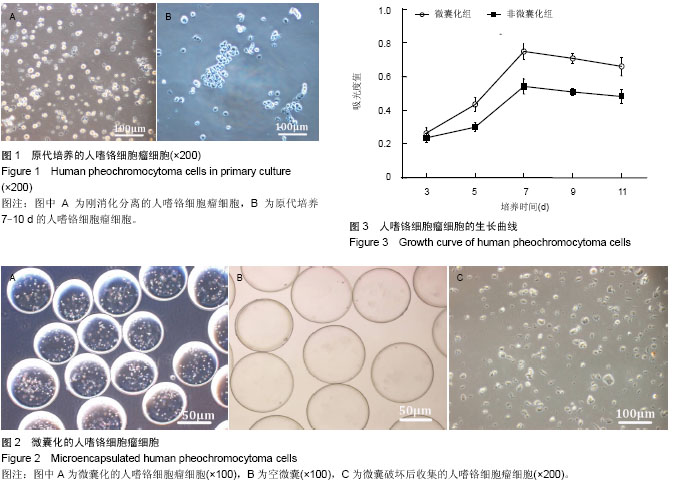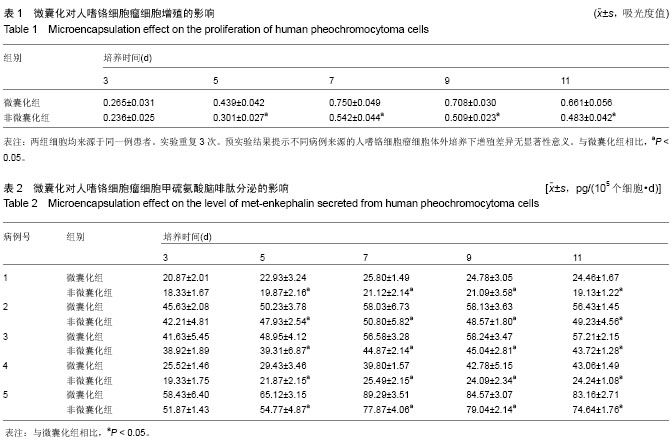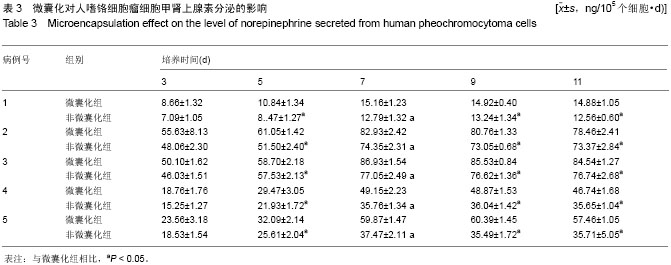| [1] Jain KK. Cell therapy for pain. Expert Opin Biol Ther. 2008; 8(12):1847-1853.
[2] Leung L. Cellular therapies for treating pain associated with spinal cord injury. J Transl Med. 2012;10:37.
[3] Vickers ER, Karsten E, Flood J, et al. A preliminary report on stem cell therapy for neuropathic pain in humans. J Pain Res. 2014;7:255-263.
[4] Sol JC, Sallerin B, Larrue S, et al. Intrathecal xenogeneic chromaffin cell grafts reduce nociceptive behavior in a rodent tonic pain model. Exp Neurol. 2004;186(2):198-211.
[5] 杨晓明,刘珺,毕好生,等.微囊化人嗜铬细胞异种移植用于实验大鼠镇痛的研究[J].空军总医院学报,2004,20(4):24-27.
[6] 肖秀斌,张伟京,薛毅珑,等.APA-BCCs微胶囊移植对晚期癌症患者的镇痛效果评价[J].中国临床康复,2004,8(20): 3953-3955.
[7] Sagen J, Pappas GD, Perlow MJ. Adrenal medullary tissue transplants in the rat spinal cord reduce pain sensitivity. Brain Res. 1986;384(1):189-194.
[8] Jeon Y, Kwak K, Kim S, et al. Intrathecal implants of microencapsulated xenogenic chromaffin cells provide a long-term source of analgesic substances. Transplant Proc. 2006;38(9):3061-3065.
[9] Kim YM, Kwak KH, Lim JO, et al. Reduction of allodynia by intrathecal transplantation of microencapsulated porcine chromaffin cells. Artif Organs. 2009;33(3):240-249.
[10] Borlongan CV, Stahl CE, Cameron DF, et al. CNS immunological modulation of neural graft rejection and survival. Neurol Res. 1996;18(4):297-304.
[11] Barker RA, Widner H. Immune problems in central nervous system cell therapy. NeuroRx. 2004;1(4):472-481.
[12] Mohammad MG, Tsai VW, Ruitenberg MJ, et al. Immune cell trafficking from the brain maintains CNS immune tolerance. J Clin Invest. 2014;124(3):1228-1241.
[13] 陈水塘,蒋建强,姜迎春.微囊化胰岛细胞异种移植治疗糖尿病的研究[J].中国药物与临床,2013,13(4):455-457.
[14] 何立敏,薛毅珑,张莉,等.微囊化大鼠胰岛异种移植于糖尿病小鼠的实验观察[J].军医进修学院学报,1999,(2):20-22.
[15] 王岩.骨髓间充质干细胞和微囊化施旺氏细胞移植促进心梗区治疗性血管新生和改善心功能的研究[D].济南:山东大学,2012.
[16] 杨宝林,刘德明,夏雯涵,等.兔微囊化许旺细胞移植对脊髓损伤大鼠髓鞘结构再生的影响[J].中国组织工程研究与临床康复,2009, 13(47):9261-9264.
[17] 王秋艳,李双月,刘婧,等.微囊化人肝细胞移植对小鼠急性肝衰竭的治疗作用[J].中国临床康复,2006,10(37):54-56.
[18] 宋涛,熊俊.微囊化肾上腺细胞移植与生物可降解材料的临床应用[J].中国组织工程研究与临床康复,2009,13(34):6773-6776.
[19] 王恩达,马云胜,穆长征,等.胰岛素产生细胞微囊化后的活力观察[J].山东医药,2012,52(3):44-45.
[20] 张英,王为,吕国军,等.体外培养和冷冻保存对微囊化细胞生长和内皮抑素表达的影响[J].中国组织工程研究与临床康复,2008, 12(45):8963-8968.
[21] 郭水龙,崔忻,罗芸,等.APA微囊包裹对牛肾上腺嗜铬细胞分泌儿茶酚胺和亮氨酸脑啡肽的影响[J].标记免疫分析与临床,2002, 9(2):80-82.
[22] 游言文,臧卫东,李鸣,等.微囊化嗜铬细胞移植产生的镇痛效应及其机制[J].中国临床康复,2005,9(14):112-113.
[23] 张伟京,肖秀斌,何立敏,等.海藻酸钠-聚赖氨酸-海藻酸钠-微囊化牛肾上腺嗜铬细胞镇痛微胶囊镇痛过程中的不良反应:初步观察[J].中国临床康复,2004,8(26):5588-5589.
[24] Leboulenger F, Charnay Y, Dubois PM, et al. The coexistence of neuropeptides and catecholamines in the adrenal gland. Research on paracrine effects on adrenal cortex cells. Ann Endocrinol (Paris). 1984;45(3):217-227.
[25] Salmi J, Pelto-Huikko M, Auvinen O, et al. Adrenal pheochromocytoma-ganglioneuroma producing catecholamines and various neuropeptides. Acta Med Scand. 1988;224(4):403-408.
[26] Saito H, Sano T, Yamasaki R, et al. Demonstration of biological activity of a growth hormone-releasing hormone-like substance produced by a pheochromocytoma. Acta Endocrinol (Copenh). 1993;129(3):246-250.
[27] Mizrachi Y, Naranjo JR, Levi BZ, et al. PC12 cells differentiate into chromaffin cell-like phenotype in coculture with adrenal medullary endothelial cells. Proc Natl Acad Sci U S A. 1990; 87(16):6161-6165.
[28] 马超,伍少玲,燕铁斌.传代培养PC12细胞的分泌特性及PENK基因表达的研究[J].解剖学研究,2008,30(3):200-202.
[29] 伍少玲,马超,燕铁斌.微囊化PC12细胞的分泌特征及其致瘤性[J].中国组织工程研究与临床康复,2008,12(36):7041-7044.
[30] Wu S, Ma C, Li G, et al. Intrathecal implantation of microencapsulated PC12 cells reduces cold allodynia in a rat model of neuropathic pain. Artif Organs. 2011;35(3):294-300.
[31] Thouënnon E, Pierre A, Tanguy Y, et al. Expression of trophic amidated peptides and their receptors in benign and malignant pheochromocytomas: high expression of adrenomedullin RDC1 receptor and implication in tumoral cell survival. Endocr Relat Cancer. 2010;17(3):637-651.
[32] 高健刚,李汉忠,张玉石,等.加兰肽等对人嗜铬细胞瘤细胞儿茶酚胺分泌功能的影响[J].中华实验外科杂志,2011,28(6):890-892.
[33] Wilczek E, Mazurkiewicz M, Otto M, et al. The effect of retinoic acid on primary cultures of human pheochromocytoma cells. Endokrynol Pol. 2006;57 Suppl A:82-87.
[34] Nakada J, Ito H, Furuta N, et al. Ultrastructure of human pheochromocytoma cells cultured for long periods. Med Electron Microsc. 2002;35(1):53-59.
[35] Pellizzari EH, Barontini M, Figuerola Mde L, et al. Possible autocrine enkephalin regulation of catecholamine release in human pheochromocytoma cells. Life Sci. 2008;83(11-12): 413-420.
[36] Venihaki M, Ain K, Dermitzaki E, et al. KAT45, a noradrenergic human pheochromocytoma cell line producing corticotropin-releasing hormone. Endocrinology. 1998;139(2): 713-722.
[37] 童安莉,曾正陪,李汉忠,等.人嗜铬细胞瘤细胞的原代培养及鉴定[J].基础医学与临床,2003,23(4):447-450.
[38] 章杨.人嗜铬细胞瘤细胞原代培养及细胞分泌功能的相关研究[D].北京:北京协和医学院,清华大学医学部,中国医学科学院, 2010.
[39] Thompson LD. Pheochromocytoma of the Adrenal gland Scaled Score (PASS) to separate benign from malignant neoplasms: a clinicopathologic and immunophenotypic study of 100 cases. Am J Surg Pathol. 2002;26(5):551-566.
[40] Lenders JW, Duh QY, Eisenhofer G, et al. Pheochromocytoma and paraganglioma: an endocrine society clinical practice guideline. J Clin Endocrinol Metab. 2014;99(6):1915-1942.
[41] Mlika M, Kourda N, Zorgati MM, et al. Prognostic value of Pheochromocytoma of the Adrenal Gland Scaled Score (Pass score) tests to separate benign from malignant neoplasms. Tunis Med. 2013;91(3):209-215.
[42] Kim YM, Jeon YH, Jin GC, et al. Immunoisolated chromaffin cells implanted into the subarachnoid space of rats reduce cold allodynia in a model of neuropathic pain: a novel application of microencapsulation technology. Artif Organs. 2004;28(12):1059-1066.
[43] Goren A, Dahan N, Goren E, et al. Encapsulated human mesenchymal stem cells: a unique hypoimmunogenic platform for long-term cellular therapy. FASEB J. 2010;24(1): 22-31.
[44] 李汉忠,王惠君,臧美孚,等.恶性嗜铬细胞瘤(附12例报告)[J].中华泌尿外科杂志,2001,22(12):14-15.
[45] 宫大鑫,王侠,李泽良,等.嗜铬细胞瘤诊疗对策[J].中国肿瘤临床, 2005,32(19):37-40.
[46] 田菁,郝权,李文录.肾上腺外恶性嗜铬细胞瘤[J].中国肿瘤临床, 2007,34(8):467-469.
[47] 史帅涛.牛肾上腺髓质嗜铬细胞蛛网膜下腔移植对大鼠的镇痛作用[D].郑州:郑州大学,2003.
[48] 杨晓明.微囊化人嗜铬细胞体外培养及异种移植用于镇痛的研究[D].武汉:华中科技大学,2001.
[49] 何立敏,薛毅珑,黎立,等.微囊化牛嗜铬细胞移植于脊髓蛛网膜下镇痛作用的研究[J].解放军医学杂志,1999,24(4):248-250.
[50] 傅志俭,宋文阁,毕好生,等.异体嗜铬细胞蛛网膜下腔移植治疗晚期癌痛病人的可行性[J].中华麻醉学杂志,2000,20(12):4-7.
[51] Fishman HA, Greenwald DR, Zare RN. Biosensors in chemical separations. Annu Rev Biophys Biomol Struct. 1998;27:165-198.
[52] 马小军.组织细胞移植与培养用生物微胶囊技术[C].南京:中国生物医学电子学学术年会,1999.
[53] 廖华,曹永英,徐达传,等.微囊对大鼠松果体细胞作用的实验研究[J].解剖学报,2005,36(1):62-65.
[54] 李新建,薛毅珑,罗芸,等.海藻酸盐-多聚赖氨酸-海藻酸盐微胶囊膜的强度和生物相容度测定[J].军医进修学院学报,2001,22(2): 94-96.
[55] Shimi SM, Hopwood D, Newman EL, et al. Microencapsulation of human cells: its effects on growth of normal and tumour cells in vitro. Br J Cancer. 1991;63(5):675-680.
[56] Wen-tao Q, Ying Z, Juan M, et al. Optimization of the cell seeding density and modeling of cell growth and metabolism using the modified Gompertz model for microencapsulated animal cell culture. Biotechnol Bioeng. 2006;93(5):887-895.
[57] Wang X, Wang W, Ma J, et al. Proliferation and differentiation of mouse embryonic stem cells in APA microcapsule: A model for studying the interaction between stem cells and their niche. Biotechnol Prog. 2006;22(3):791-800.
[58] Livett BG, Dean DM, Whelan LG, et al. Co-release of enkephalin and catecholamines from cultured adrenal chromaffin cells. Nature. 1981;289(5795):317-319.
[59] Pappas GD, Lazorthes Y, Bès JC, et al. Relief of intractable cancer pain by human chromaffin cell transplants: experience at two medical centers. Neurol Res. 1997;19(1):71-77.
[60] Schultzberg M, Hökfelt T, Lundberg JM, et al. Enkephalin-like immunoreactivity in nerve terminals in sympathetic ganglia and adrenal medulla and in adrenal medullary gland cells. Acta Physiol Scand. 1978;103(4):475-477.
[61] Budai D, Fields HL. Endogenous opioid peptides acting at mu-opioid receptors in the dorsal horn contribute to midbrain modulation of spinal nociceptive neurons. J Neurophysiol. 1998;79(2):677-687.
[62] Pasternak GW, Pan YX. Mu opioids and their receptors: evolution of a concept. Pharmacol Rev. 2013;65(4): 1257-1317.
[63] Shechter Y, Heldman E, Sasson K, et al. Delivery of neuropeptides from the periphery to the brain: studies with enkephalin. ACS Chem Neurosci. 2010;1(5):399-406.
[64] Ossipov MH, Morimura K, Porreca F. Descending pain modulation and chronification of pain. Curr Opin Support Palliat Care. 2014;8(2):143-151.
[65] Duplan H, Li RY, Vue C, et al. Grafts of immortalized chromaffin cells bio-engineered to improve met-enkephalin release also reduce formalin-evoked c-fos expression in rat spinal cord. Neurosci Lett. 2004;370(1):1-6. |


